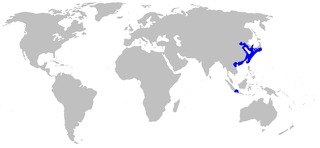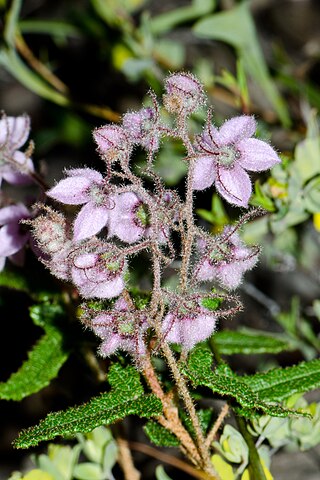
Paphiopedilum, often called the Venus slipper, is a genus of the lady slipper orchid subfamily Cypripedioideae of the flowering plant family Orchidaceae. The genus comprises some 80 accepted taxa including several natural hybrids. The genus is native to Southeast Asia, the Indian Subcontinent, southern China, New Guinea and the Solomon and Bismarck Islands. The type species of this genus is Paphiopedilum insigne.

Adiantum, the maidenhair fern, is a genus of about 250 species of ferns in the subfamily Vittarioideae of the family Pteridaceae, though some researchers place it in its own family, Adiantaceae. The genus name comes from Greek, meaning "unwetted", referring to the fronds' ability to shed water without becoming wet.

The finback catsharks are a small family, the Proscylliidae, of ground sharks. They can be found in warm seas worldwide and are often the most numerous and common shark in tropical regions. They are generally less than 1 m in length, and are slow-moving predators that feed on bony fish and small invertebrates. Although some bear live young, the majority lay eggs with almost fully developed young; these egg cases, known as "mermaid's purses", are unique in appearance to each species.

The graceful catshark is a species of finback catshark, belonging to the family Proscylliidae. This shark is found in the western Pacific Ocean, from southeastern Japan to Vietnam and northwestern Java, at depths between 50 and 100 m. Females can reach a length of 65 cm.

Paphiopedilum venustum is a species of orchid ranging from eastern Nepal to northeastern Bangladesh.
Hemisorghum is a genus of Asian plants in the grass family.
Eupyrrhoglossum is a genus of moths in the family Sphingidae first described by Augustus Radcliffe Grote in 1865.
The genus Proscyllium is a small genus of finback catsharks in the family Proscylliidae.
Anthidium venustum is a species of bee in the family Megachilidae, the leaf-cutter, carder, or mason bees.

Adiantum venustum, the evergreen maidenhair or Himalayan maidenhair, is a species of fern in the genus Adiantum of the family Pteridaceae, native to China and the Himalayas. It is a slow to establish plant that usually grows on moist rocks and soil with a good amount of humus and dead leaves. It is very hardy, largely evergreen to -10 °C, when it becomes deciduous. It is also known as black Hansraj in India for its black stalks at the fronds.

Calliostoma venustum is a species of sea snail, a marine gastropod mollusk in the family Calliostomatidae.
Carenum venustum is a species of ground beetle in the subfamily Scaritinae. It was described by Sloane in 1897.

Crinum lorifolium is a species of flowering plants in the family Amaryllidaceae. It is found in India and Myanmar.

Callimation venustum is a species of beetle in the family Cerambycidae. It was described by Félix Édouard Guérin-Méneville in 1844. It is known from Madagascar. It contains the variety Callimation venustum var. obscurum.
Spectamen venustum is an extinct species of sea snail, a marine gastropod mollusk, in the family Solariellidae.

Plagiomnium venustum, also known as magnificent leafy moss, is a species of moss belonging to the family Mniaceae. It is found mainly in western North America along the coastal region. This moss can be identified from other members of the Plagiomnium genus by dark coloured stomata guide cells and the absence of sterile stems. It is most commonly found growing as a mat on a variety of substrate, but mainly on humus and moist soil.
Gaudium venustum is a species of spreading shrub that is endemic to Queensland. It has thin, rough, scaly bark, broadly elliptical leaves, deep pink flowers borne singly on side shoots and fruit that is fleshy and succulent at first.

Gompholobium venustum, commonly known as handsome wedge-pea, is a species of flowering plant in the family Fabaceae and is endemic to the south-west of Western Australia. It is a slender, erect or sprawling shrub with pinnate leaves with fifteen to nineteen leaflets, and yellow or pink, pea-like flowers.
Bradypodion venustum is endemic to South Africa.

Lasiopetalum venustum is a species of flowering plant in the family Malvaceae and is endemic to a restricted area in the south-west of Western Australia. It is an erect shrub with hairy stems, egg-shaped, three-lobed leaves and pink and dark red flowers.












